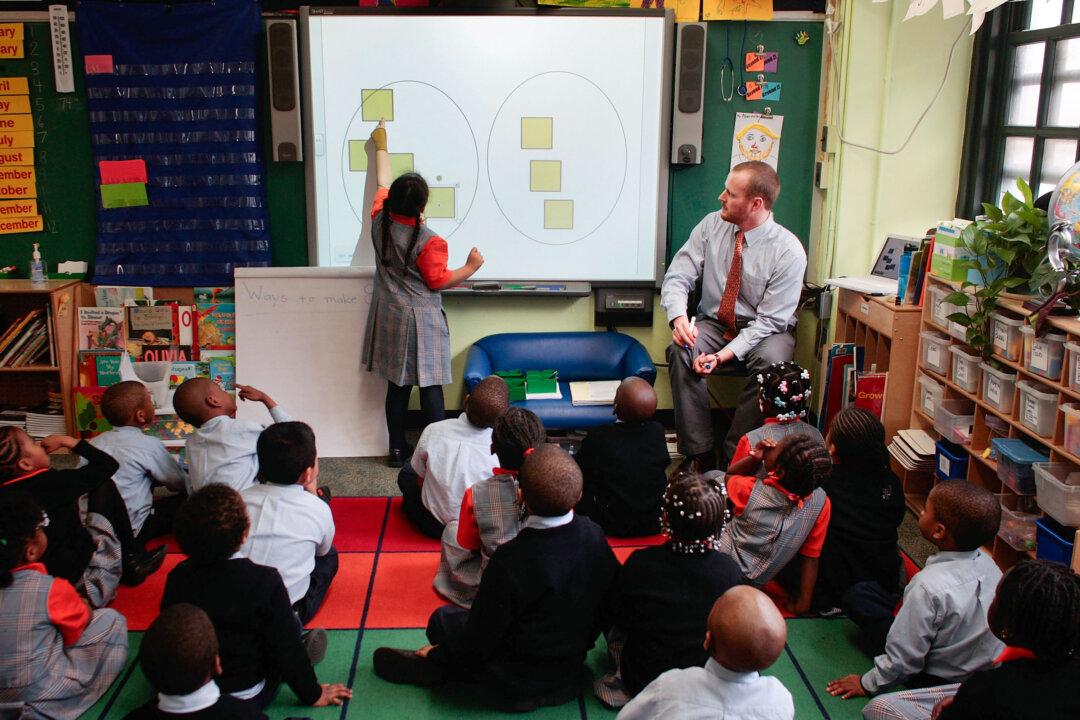The largest K–12 public school district in the nation will overhaul its math instruction program in the approaching 2024–2025 academic year, adopting a more creative approach to teaching problem-solving that millions of students in other states already use.
The Illustrative Mathematics (IM) curriculum will be applied in New York City Public Schools across 93 middle schools and 420 high schools as part of the NYC Solves Initiative, which aims to improve test scores and student performance, according to a statement that Mayor Eric Adams issued last month.
After that announcement, a series of public presentations on the change took place. Teachers in grades 6–12 are completing training ahead of the first day of classes in September, and IM will be phased in at elementary schools across the district in the coming academic years.
New York City public officials tout IM as a way to boost student performance and improve equity in their public school system. Last year, more than half of the students in grades 3–8 were below proficiency levels in math, and there is a 36-point gap in average test scores between white and black students (and a 43-point gap between Asian and Hispanic students), according to the district website.
IM was developed in 2011 and meets the standard for the Common Core curriculum used across the country. Common Core was an initiative to establish comparable standards for math and English language arts between states. Although the IM curriculum is trademarked, the Illustrative Mathematics company offers its instructional materials for free.
IM differs from traditional math instruction methods that are still prevalent in most districts, although the newer curricula are spreading rapidly. For example, instead of walking through a problem with a teacher and then mimicking what was shown to them, students are expected to grasp the math process visually, discuss strategies for solving the problem with classmates, and explain their reasoning to the teacher, who then provides additional guidance for learning a process or solving a problem, according to information provided on the NYC Solves and Illustrative Mathematics websites.
Real-world experiences lend themselves to this learning model. With a trip to the grocery store, whether in-person or virtually, students can conceptualize and apply addition, subtraction, division, multiplication, algebra, and even higher-level math processes as they navigate the challenges of budgeting, purchasing items, following recipes, or planning meals.
Kayla Dawes, a middle school teacher at Frederick Douglass Academy in Harlem, completed the curriculum training on July 19. She was already familiar with IM and had incorporated some of its core principles in her work as a tutor across various academic levels, from special education to Regents Algebra.
“The hope is students will be able to create their knowledge,” Ms. Dawes said during a July 24 interview with The Epoch Times. “Getting kids started, getting them engaged—that’s what it’s really great for.”
Ms. Dawes provided examples of how IM is applied across different grade levels.
When teaching sixth graders the concept of area, four different tiles are shown to the class. The tiles are a mix of color schemes, and one tile has gaps without color. Ms. Dawes said the students are asked which tile does not belong even though there is no incorrect answer.
Students then work in pairs to fill the area inside a tile with combinations of three shapes—triangles, rhombuses, and trapezoids—before everyone discusses their work. The teacher then asks questions about how and why each shape was chosen.
For a high school Algebra I class, students work in pairs to solve a problem. In this case, there is a right or wrong answer, Ms. Dawes said, but in this instance, the teacher and students work together to break down the problem into a series of equations, troubleshoot, and show and tell what was done incorrectly as opposed to reciting only the correct application.
She said IM is based on a proven psychological concept that students who construct knowledge themselves are more likely to retain that information. Similarly, they will grasp a concept better if they learn from their mistakes rather than simply reciting the correct answer.
Still, Ms. Dawes said, educators face many uncertainties with this new curriculum. Teachers were not provided with any evidence that IM will improve test scores. The problem-solving process takes a lot more time, so students aren’t getting the repetition that develops math muscle memory. Students might not have peers or a parent to collaborate with when completing homework assignments, which is contrary to the learning model. And there will be resistance and pushback from math teachers who advocate rigorous coursework and were successful with the old curriculum.
“I do like that we are giving every student a voice and showing them that their work has value,” Ms. Dawes said. “If we are going to make the shift, we need to get the community involved. It’s a shift for parents as well.”
According to the Illustrative Mathematics 2023 annual report, 2.13 million students and 42,233 teachers in 1,833 districts across the country used the curriculum last year, up significantly from 485,703 students and 5,008 teachers across 921 districts in 2020. This list includes the Los Angeles Unified School District, the second-largest public K–12 system in the United States.
Illustrative Mathematics company officials declined to speak with The Epoch Times, but the company’s website provides case studies from districts in three states.
The Homer Plessy Community Schools district, which serves middle school students in a New Orleans neighborhood, increased the average state test score for eighth grade math by 13 percent one year after the district implemented IM in 2021, according to the case study.
In Des Moines, Iowa, the case study cited a 2022 survey that said students and educators found the Illustrative Mathematics curriculum more engaging and enjoyable than the prior materials, but it did not provide any data regarding improved test scores or student performance.
Likewise, the 2022 case study of grades K–5 in the Greeley-Evans District 6 in Colorado did not provide any figures pertaining to academic achievement, but it did say classroom behavior improved as the number of discipline referrals decreased to 300 from 700 in one year because the students were more interested in their work and did not cause disruptions out of boredom.
“We had to get them out of passive learning,” Alison Ferguson, a principal in the school district, said in the case study, “and IM helped with that in a lot of ways.”







